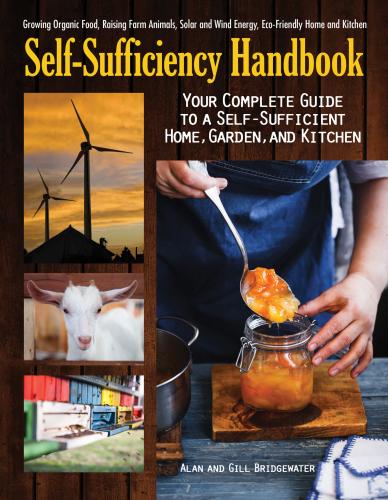Self-Sufficiency
Handbook
ALAN AND GILL BRIDGEWATER
Self-Sufficiency Handbook
CompanionHouse Books™ is an imprint of Fox Chapel Publishers International Ltd.
Project Team
Vice President–Content: Christopher Reggio
Editor: Amy Deputato
Copy Editor: Laura Taylor
Design: Mary Ann Kahn
Index: Elizabeth Walker
Copyright © 2017 by IMM Lifestyle Books
All rights reserved. No part of this book may be reproduced, stored in a retrieval system, or transmitted in any form or by any means, electronic, mechanical, photocopying, recording, or otherwise, without the prior written permission of Fox Chapel Publishers, except for the inclusion of brief quotations in an acknowledged review.
ISBN 978-1-62008-234-8
Library of Congress Cataloging-in-Publication Data
Names: Bridgewater, Alan, author. | Bridgewater, Gill, author.
Title: The self-sufficiency handbook : your complete guide to a self-sufficient home, garden, and kitchen / Alan and Gill Bridgewater.
Description: Mount Joy, PA : Fox Chapel Publishing, [2017] | Includes index.
Identifiers: LCCN 2017040707 (print) | LCCN 2017047215 (ebook) | ISBN 9781620082355 () | ISBN 9781620082348 (softcover)
Subjects: LCSH: Self-reliant living. | Organic living.
Classification: LCC GF78 (ebook) | LCC GF78 .B74 2017 (print) | DDC 640--dc23
LC record available at https://lccn.loc.gov/2017040707
This book has been published with the intent to provide accurate and authoritative information in regard to the subject matter within. While every precaution has been taken in the preparation of this book, the author and publisher expressly disclaim any responsibility for any errors, omissions, or adverse effects arising from the use or application of the information contained herein. The techniques and suggestions are used at the reader’s discretion and are not to be considered a substitute for veterinary care. If you suspect a medical problem, consult your veterinarian.
| Fox Chapel Publishing 903 Square Street Mount Joy, PA 17552 | Fox Chapel Publishers International Ltd. 7 Danefield Road, Selsey (Chichester) West Sussex PO20 9DA, U.K. |
www.facebook.com/companionhousebooks
Printed and bound in Singapore
20 19 18 17 2 4 6 8 10 9 7 5 3 1
Contents
Part 2:The Self-Sufficient House
Part 3:The Organic Food Garden
A-Z of Vegetables and Salad Crops
Introduction
WHEN GILL AND I MET IN ART SCHOOL in the 1960s, the whole place was buzzing with a new kind of freedom. Somehow, we all felt that we could do it—life—better than previous generations.
I remember one evening, sitting in a college common room, listening to two young American hippie lecturers animatedly talking about how very soon we would all be forced by the failure of oil supplies to return to some sort of Amish-type self-sufficiency—log cabins, horses instead of cars, communes where groups of like-minded people pulled together to create a better society—and it was very exciting. As they saw it, and as many other people saw it, our consumer society was living off the fast-shrinking capital resources of the earth. Their thinking was that ever since the start of the Industrial Revolution, we had been taking good and leaving behind bad: taking the coal and leaving the waste, taking the oil and leaving pollution, taking the goodness from the soil and leaving it barren, taking down trees and leaving nothing in their place, and so on.
The big question at that time was, “How can we change from being a greedy, grabbing, take-it-and-run, dirty, despoiling society to a greener, more giving society?” The general consensus of opinion among college students was that the best way forward was not to try to change things from the center outward. As Timothy Leary said in the 1960s, “Turn on, tune in, drop out,” meaning that we should look inward at ourselves, look outward at society, and then, in light of our knowledge, select and reject. The idea was that changes were best made from the edges inward.
My reading list at that time was topped by two books: Cottage Economy by William Cobbett and Walden by Henry David Thoreau. Cottage Economy, first published in 1821, is one of the very first self-help manuals in that it describes in blow-by-blow detail how “a large part of the food of even a large family may be raised . . . from forty rods, or quarter of an acre.” In Walden, published in 1854, Thoreau describes how, upon deciding that he was going to set up his self-sufficient home in a hut in the woods, he started thinking about the implications of every minute detail, from the orientation of the hut in relation to the sun to how he could survive on fish and beans. Further, Thoreau attacked the way things were being done at that time: the rip-tear-slash-and-burn farming, the development of the railroads, and the growth of the cities, all at the expense of nature. Gill and I read these books avidly, and we found the notion of being completely independent with no electricity, no plumbing, and the like so stimulating.
By the end of the 1960s, we were married and living in a ramshackle house in the middle of a field with no running water, no electricity, no mortgage; in fact,
